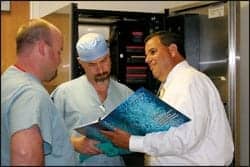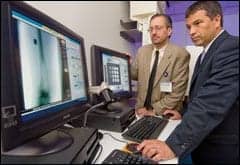 |
| For a comprehensive quality assurance program, include staff members across all areas of responsibility. |
Sterilizer service seems to be an area of asset management that eludes most comprehensive clinical engineering programs. However, sterilization touches nearly every patient who comes to a medical facility. This “touch” can have a tremendous impact on the quality of care delivered by the medical practitioner. Sterilizer maintenance and education is a crucial and valuable part of asset management. Maintaining sterilizers not only protects patients, but also lowers a facility’s infection rate. By developing a robust sterilizer asset management plan, a facility can realize sizable cost savings due to the effect on nosocomial infections and sterilizer life-cycle costs. Although different types of sterilization are used, this article will focus on steam sterilization.
Laying the Groundwork
It is imperative for clinical engineering to be involved on the ground floor of the device-planning process. Planning, design, and installation parameters are key factors in the success of a new device, and front-end involvement provides an excellent result for the life-cycle costs associated with the device.
Common errors associated with the lack of preparation for a new sterilizer are location, location, location. What this means is that poor planning can result in utilities placed in the wrong location, inadequate supply, and/or poor quality. Other problems include devices located too close to one another, insufficient space for service, and drains not located under devices. Consider workflow issues when locating the sterilizer. For example, it would be improper to have your sterilizer located in the decontamination section of the work area. The ANSI/AAMI publication ST79:2006 edition provides a nice road map for workflow planning.
Utilities
Steam and water quality are very important to the sterilization process. Clean, dry, 97% saturated steam is imperative for a successful process to sterilize instrumentation. If the steam is too wet, then the typical complaint is wet loads. If the steam is too dry or superheated, then errors in quality testing will arise. Those errors include failed daily air removal test (DART) or Bowie-Dick tests, which check for air removal. A severe enough problem can result in a cycle failure.
Water quality and pressure are two factors that play a role in air removal for most prevacuum sterilization. Many prevac sterilizers produce the vacuum using a venturi effect by passing water through a small orifice, and some prevacuum sterilizers use pumps. Hard water causes obstructions due to lime and scale buildup. Again, this causes wet loads or failed DART and Bowie-Dick tests.
Operation and Management
Clinical engineering can provide education for operators of steam sterilization devices. Through a relationship with original equipment manufacturers (OEMs) and department managers, clinical engineering continues to provide the latest in AAMI/ANSI guidelines for sterilization. Just as clinical engineering is the technology leader at any facility, steam sterilization technology should not be any different. By providing continuing education, we can ensure that operators have the latest safety instructions and operate the devices for long life and low costs.
Quality Assurance
Validation of the quality of steam sterilization uses several different methods, including chemical and biological indicators. These chemical and biological indicators are typically purchased from the manufacturer of the sterilizer or other vendors. Physical monitors are also used.
There are five classes of chemical indicators, but not all chemical indicators are used to release sterilized loads. Some are only used for indication that the package was exposed to steam and not necessarily that all parameters were met for sterilization. Chemical indicators include a DART test, which validates the function of the vacuum system and/or air leaks that could be produced by faulty gaskets, air inlet valves, a faulty vacuum system, leaks in the chamber, leaks in the plumbing, operators running the wrong cycle, and/or faulty check valves. The Bowie-Dick test is similar to the DART test, and these monitors may be used interchangeably. These tests are prepackaged and ready-to-go, simple-use devices.
Biological indicators, such as Geobacillus Stearothermophilus spores, are used to test the efficiency of the sterilization process and sterilizer due to their high level of resistance to steam. Other biological indicators include an enzyme for a rapid readout. These are generally used for implants because implants are usually not purchased by the facility before surgery but are loaned on consignment from vendors. Rapid-response indicators can be used after maintenance on the device to get the machine back in service as soon as possible. There are two types of spores: one used for flash/gravity sterilization and another used for prevac sterilization. It is important not to use a flash-type spore to validate a prevac cycle, or vice versa. The packaging for these two types of spore testing is vastly different, with the prevac test package significantly more challenging than the flash/gravity cycle spore.
Physical monitors include the use of gauges, clocks, displays, recordings, and other physical devices mounted or used by the device.
For a comprehensive quality assurance program, include staff members across all areas of responsibility such as the operators in SPD and surgery, health system–owned clinics, the microbiology laboratory, infection control, risk management, and clinical engineering. This team can help ensure an effective and efficient sterilization process that includes planning, design, installation, operations, problem identification, and disposal at the end of useful life. Operators can conduct daily quality testing, which includes chemical and biological tests. Microbiology can process the biological tests and report results to end users, unless a problem culture is identified, in which case other departments should be notified, such as clinical engineering and infection control. Spreading these responsibilities across these areas ensures that each area process is validated by a different department. It would not be prudent for clinical engineering to validate its work via postmaintenance spore testing. This would be like leaving a fox to watch the henhouse, and results would be suspect.
 |
| Clinical engineering can provide education for operators of sterilizers to ensure they have the latest safety instructions. |
Keeping Sterilizers Operational
Preventive maintenance (PM) on steam sterilizers is largely based on safety. These devices are pressurized vessels, and some states require pressure vessel inspections to ensure safe use. PM checks cover door inspection, including gaskets, diaphragms, and locks; water, steam, and safety valve inspections; calibrations of pressure and temperature; electrical safety and electrical components; and overall device condition. Part of the maintenance program includes the replacement of several items such as valves or valve kits for rebuilding, door gaskets, and diaphragm gaskets. The typical time to complete PM on a large steam sterilizer is approximately 4 to 6 hours. The cost for parts can range from approximately $500 to $1,300, depending on the device and parts sourcing.
Corrective maintenance on steam sterilizers can be as simple as fixing a loose fitting causing an air leak to the replacement of control systems or a door assembly. Most common problems for these devices are leaks of air, water, or steam. Repairing leaks can involve simple fixes of parts such as temperature probe bushings and valves. Other repairs, such as air leaks, can be very complicated and may involve heat exchangers and internal plumbing leaks that are not visible. Learning good troubleshooting processes is essential when servicing these devices.
DART test failures indicate possible air leaks. Troubleshooting begins with a search for visual defects by running a test cycle and looking for obvious problems. Sometimes, it can be as easy as a user error—the user could potentially run the wrong test cycle for the DART test or the user could wrongly position the DART test device away from the drain area. DART tests must be placed as close to the drain as possible or according to manufacturer specifications. Both situations could cause a failed DART test. Do not start troubleshooting a problem without verification by running a test cycle or reading the device printout.
If steam is seen leaking during this test cycle, then corrective action must be taken to solve the problem. If steam is leaking out, then air is getting into the chamber. Typical corrective actions include bushing replacement, gasket replacement, air inlet valve rebuilding or replacement, check valve rebuilding or replacement, and even a heat exchanger replacement if used on the device. If one of these is not the problem, then a complete check of the plumbing is required.
Biological indicator failures are rare and are typically due to poor incubation, the wrong cycle run for the spore test, and/or the wrong spore used for the device being tested. If a valid failed spore test occurs, then employ troubleshooting steps similar to those discussed above in addition to verification of temperature and pressure calibration.
Other problems with steam sterilizers include, but are not limited to, jacket flooding; wet loads taking too long to charge, exhaust, or evacuate (prevac sterilizers); or failure of a component such as a printer or PCB. Faulty steam traps or obstructions in the drain line such as lint or sticker buildup in the strainer typically cause jacket flooding. Lime or mineral buildup is also a common problem in these drain lines. Wet loads are caused by bad steam valves; bad check valves; low water pressure or poor steam quality (too wet or too low of a pressure); faulty vacuum systems including worn pumps or ejectors, or improperly loaded and/or prepared sterilization. No sterilizer is designed to remove excess moisture. Wet loads sometimes require a team effort to solve by educating the operators. Do not confuse a wet pack with a wet load; one wet pack does not mean there is a sterilizer failure.
Devices that take too long to charge can be the result of operator error, steam inlet valve failure, exhaust valve failure, steam-quality pressure too low, or a steam trap failure. Devices that take too long to exhaust can have a drain valve failure or a steam valve failure. A faulty air inlet valve, a faulty vacuum system, an air leak, or electronic control failure can cause an evacuation failure on a prevac sterilizer.
The typical in-house asset management program for steam sterilizers should yield an approximate savings over OEM service of 35% to 60%.
A Successful Outcome
Professional organizations such as the Association for the Advancement of Medical Instrumentation, the Association of Perioperative Registered Nurses, the Occupational Safety and Health Administration, the Society of Gastroenterology Nurses and Associates, the International Association of Healthcare Central Association of Materiel Management, and the American Society for Healthcare Central Service Professionals, as well as OEMs and other respected third-party organizations, can offer a wealth of information and assistance on sterilization. Clinical engineering departments provide technical expertise and leadership in asset management for all clinical technology used in health care. Clinical engineering presents a tremendous resource of information for our coworkers. Following this brief road map can lead to a successful service delivery program and take the mystery out of servicing these devices.
Rocky Jackson and John Heidebrecht are members of the clinical engineering department, St John’s Regional Health System, Springfield, Mo; and Christopher G. Nowak, CBET, is regional director, Mercy Clinical Engineering Services, St John’s Regional Health System. For more information, contact





